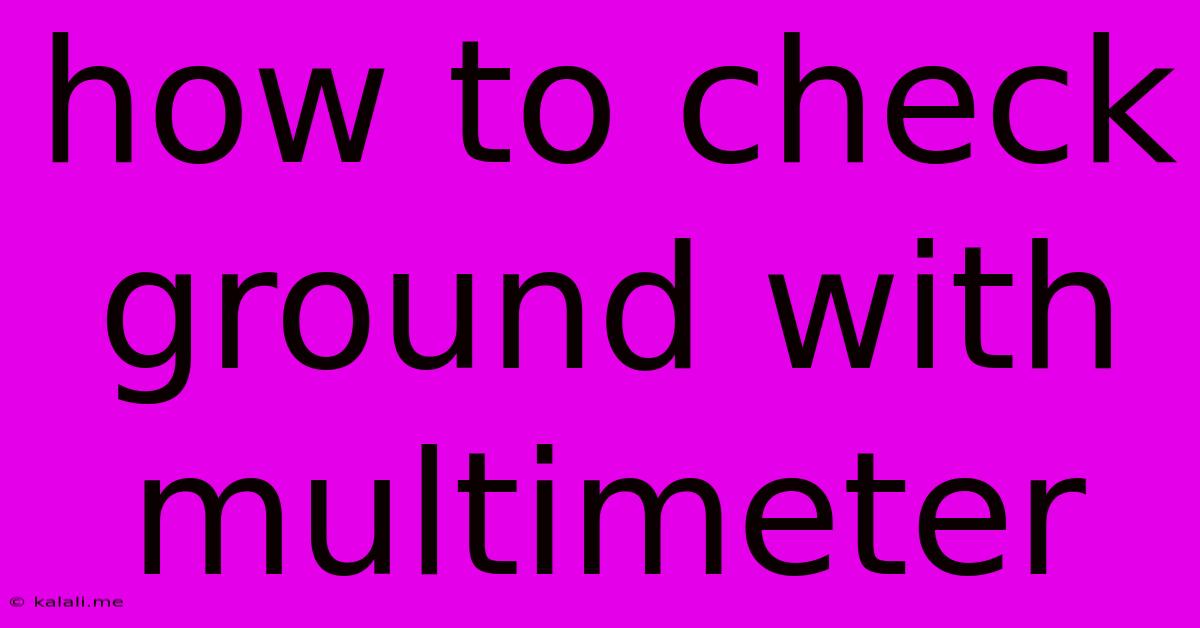How To Check Ground With Multimeter
Kalali
Jun 03, 2025 · 4 min read

Table of Contents
How to Check Ground with a Multimeter: A Comprehensive Guide
Meta Description: Learn how to safely and effectively check your ground connection using a multimeter. This guide covers various testing methods and troubleshooting tips for ensuring electrical safety.
Grounding is crucial for electrical safety, preventing shocks and protecting equipment. A faulty ground can lead to dangerous voltage buildup, potentially causing damage or injury. This guide will walk you through how to effectively check your ground connection using a multimeter, a fundamental tool for any electrician or DIY enthusiast. We'll explore different testing methods and provide troubleshooting advice to ensure your electrical system is safe and reliable.
Understanding Grounding Basics
Before we dive into the testing process, let's briefly review the importance of grounding. A ground connection provides a low-resistance path for electrical current to flow to the earth in case of a fault. This prevents dangerous voltages from accumulating on metal surfaces, protecting both people and equipment. A properly grounded system ensures that stray currents are safely dissipated, minimizing the risk of electric shock or equipment damage. Common grounding points include ground rods driven into the earth, metal water pipes, and dedicated grounding wires connected to electrical panels.
Tools You'll Need
To check your ground connection, you'll need the following:
- Multimeter: A digital multimeter (DMM) is ideal for precise measurements. Analog multimeters can also be used, but digital multimeters offer better readability and accuracy.
- Test Leads: These are the probes that connect the multimeter to the circuit. Ensure they are in good condition and properly connected.
- Screwdriver: You may need a screwdriver to access grounding terminals or connections.
- Safety Glasses: Always wear safety glasses when working with electricity.
Methods for Checking Ground with a Multimeter
There are several ways to check your ground using a multimeter, depending on the specific situation and what you're testing.
1. Checking Ground Continuity
This method verifies the presence of a continuous path from the ground point to the earth.
- Set your multimeter: Select the continuity test setting (usually represented by a diode symbol or a sound icon).
- Connect the probes: Connect one test lead to the grounding point you are testing (e.g., a grounding wire or a metal pipe). Connect the other test lead to a known good ground, such as a metal water pipe (ensure it's electrically connected to the earth) or a ground rod.
- Observe the reading: A continuous beep or a low resistance reading (ideally close to zero ohms) indicates a good ground connection. A lack of continuity indicates a problem in the grounding path.
2. Measuring Ground Resistance
This method measures the resistance of the ground connection, offering a more quantitative assessment of its effectiveness.
- Set your multimeter: Select the resistance setting (usually represented by the Greek letter Omega, Ω). Choose an appropriate range, starting with a lower range (e.g., 200Ω) and increasing if necessary.
- Connect the probes: Connect one test lead to the grounding point and the other test lead to a known good ground.
- Observe the reading: A low resistance value indicates a good ground. High resistance suggests a problem, potentially due to corrosion, a loose connection, or a broken wire. The acceptable resistance value varies depending on the specific application and local regulations.
3. Voltage Drop Test (Between Ground and Earth)
This test checks for voltage differences between your ground and the earth itself. A significant voltage drop might indicate a grounding problem.
- Set your multimeter: Select the DC voltage setting.
- Connect the probes: Connect one test lead to your ground point and the other test lead to a separate earth ground (e.g., a ground rod far away from your first test point).
- Observe the reading: Ideally, the voltage should be close to zero. A significant voltage suggests a potential issue with your grounding system.
Troubleshooting Grounding Problems
If your tests reveal a grounding problem, here's what you can do:
- Inspect connections: Check for loose connections, corrosion, or broken wires. Tighten any loose connections and clean corroded areas.
- Trace the grounding path: Follow the grounding wire to identify any breaks or points of high resistance.
- Check for broken wires: Look for any visual signs of damage to the grounding wire.
- Replace faulty components: If necessary, replace damaged wires or connectors.
Remember: Always prioritize safety. If you're unsure about any aspect of electrical work, consult a qualified electrician. Improper grounding can be dangerous.
This comprehensive guide provides various methods to check your ground with a multimeter. By understanding these techniques and troubleshooting steps, you can ensure the safety and reliability of your electrical system. Remember, a good ground is essential for protecting both your equipment and yourself.
Latest Posts
Latest Posts
-
Do Two Lines In Four Dimensions Only Intersect Once
Jun 05, 2025
-
How To Remove Schlage Door Handle
Jun 05, 2025
-
What Did God Crate The Water
Jun 05, 2025
-
How To Stop Opening Up With Launcpad
Jun 05, 2025
-
How Do You Clean Mold Off Concrete
Jun 05, 2025
Related Post
Thank you for visiting our website which covers about How To Check Ground With Multimeter . We hope the information provided has been useful to you. Feel free to contact us if you have any questions or need further assistance. See you next time and don't miss to bookmark.